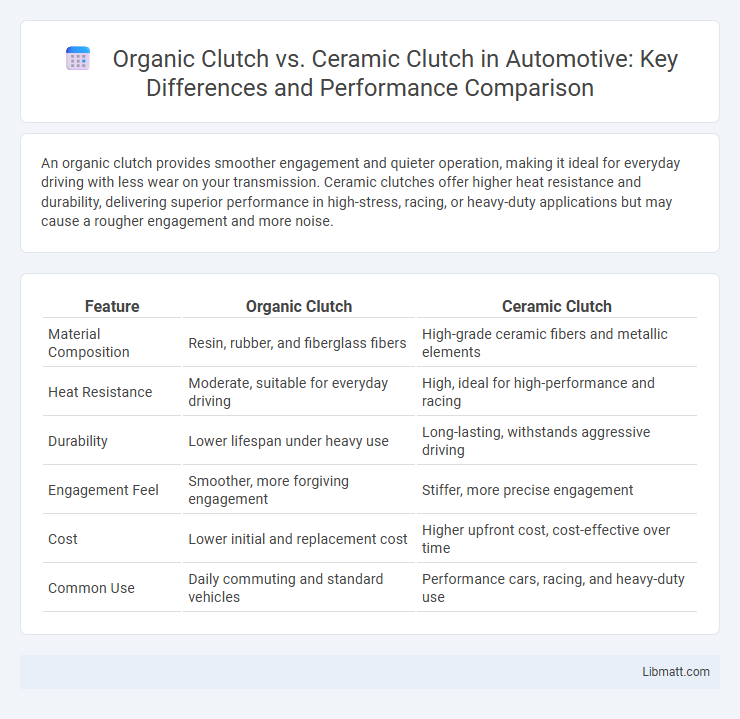An organic clutch provides smoother engagement and quieter operation, making it ideal for everyday driving with less wear on your transmission. Ceramic clutches offer higher heat resistance and durability, delivering superior performance in high-stress, racing, or heavy-duty applications but may cause a rougher engagement and more noise.
Table of Comparison
| Feature | Organic Clutch | Ceramic Clutch |
|---|---|---|
| Material Composition | Resin, rubber, and fiberglass fibers | High-grade ceramic fibers and metallic elements |
| Heat Resistance | Moderate, suitable for everyday driving | High, ideal for high-performance and racing |
| Durability | Lower lifespan under heavy use | Long-lasting, withstands aggressive driving |
| Engagement Feel | Smoother, more forgiving engagement | Stiffer, more precise engagement |
| Cost | Lower initial and replacement cost | Higher upfront cost, cost-effective over time |
| Common Use | Daily commuting and standard vehicles | Performance cars, racing, and heavy-duty use |
Introduction to Organic and Ceramic Clutches
Organic clutches are made from a blend of natural fibers, resin, and rubber compounds, offering smooth engagement and low noise for everyday driving and moderate performance needs. Ceramic clutches use a composite of ceramic materials, providing higher heat resistance and greater durability under extreme performance conditions, ideal for racing or heavy-duty use. Choosing the right clutch depends on your driving style and vehicle demands, balancing comfort with performance requirements.
Composition and Material Differences
Organic clutches are composed of resin-impregnated fibers, typically containing materials like Kevlar or paper, which provide smooth engagement and quieter operation. Ceramic clutches use a metallic ceramic compound that offers higher heat resistance and durability, ideal for handling greater torque and aggressive driving conditions. The fundamental material differences impact performance characteristics, with organic clutches favoring comfort and ceramics excelling in high-performance environments.
Performance Characteristics
Organic clutches offer smoother engagement and quieter operation, making them ideal for everyday driving and moderate performance needs. Ceramic clutches provide higher heat resistance and greater friction capacity, which enhances performance during aggressive driving or racing conditions. You should consider ceramic clutches if you require superior durability and faster response under extreme stress.
Durability and Longevity
Organic clutches offer smoother engagement but tend to wear out faster due to their friction material composition, typically lasting between 30,000 to 50,000 miles under normal driving conditions. Ceramic clutches, made from hardened ceramic materials, provide significantly higher durability and longevity, often exceeding 70,000 miles, making them ideal for high-performance or heavy-duty applications. Your choice depends on balancing the need for comfort with the requirement for extended service life and resistance to heat and wear.
Heat Resistance and Thermal Stability
Ceramic clutches exhibit superior heat resistance compared to organic clutches, maintaining performance under extreme temperatures up to 900degF (482degC) without significant degradation. Organic clutches tend to soften and wear faster when exposed to high thermal loads, typically tolerating temperatures up to 500degF (260degC). The enhanced thermal stability of ceramic clutches results in longer lifespan and consistent friction performance during intensive driving or racing conditions.
Smoothness and Engagement Feel
Organic clutches provide smooth engagement with a softer feel, making them ideal for daily driving and easy modulation. Ceramic clutches offer a firmer, more aggressive engagement with less pedal travel, suitable for high-performance applications but may feel harsher during low-speed maneuvers. Choosing between the two depends on whether you prioritize comfort and smoothness or performance and precise response in your driving experience.
Noise and Vibration Levels
Organic clutches typically produce lower noise and vibration levels due to their softer friction materials, resulting in smoother engagement and quieter operation. Ceramic clutches, made from harder materials, generate higher noise and vibration during engagement, often leading to a more aggressive and tactile driving feel. Drivers seeking a quieter and more comfortable ride usually prefer organic clutches for reduced NVH (Noise, Vibration, and Harshness) characteristics.
Cost Comparison and Affordability
Organic clutches generally cost less upfront compared to ceramic clutches, making them a more affordable choice for everyday driving and budget-conscious users. Ceramic clutches offer superior durability and heat resistance but come with a higher price tag, often two to three times more expensive than organic options. Your decision should weigh long-term performance benefits against initial cost, especially if frequent gear changes and high-stress conditions demand a more robust clutch.
Ideal Applications and Use Cases
Organic clutches excel in everyday driving and light performance vehicles due to their smooth engagement and quieter operation, making them ideal for daily commutes and street use. Ceramic clutches are better suited for high-performance and racing applications, as they offer superior heat resistance and durability under extreme conditions but tend to produce more noise and harsher engagement. Choosing between organic and ceramic clutches depends on the driver's priority for comfort versus performance demands.
Choosing the Right Clutch for Your Vehicle
Choosing the right clutch for your vehicle depends on driving style and performance needs, where organic clutches offer smoother engagement and better wear resistance for daily driving. Ceramic clutches provide higher heat tolerance and increased friction, making them ideal for high-performance or racing applications requiring rapid response and durability under extreme conditions. Prioritize organic clutches for comfort and longevity, while ceramic clutches excel in power transfer and aggressive driving scenarios.
organic clutch vs ceramic clutch Infographic

 libmatt.com
libmatt.com